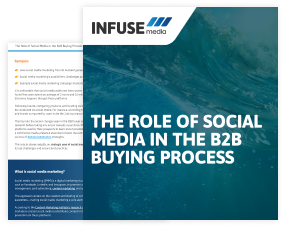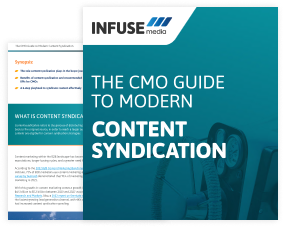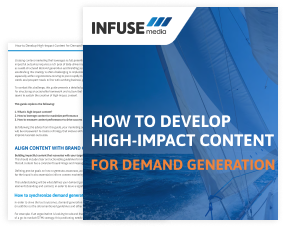For most marketers and CEOs, lead generation is the primary objective of marketing—some even consider it its only goal. For instance, according to Ruler Analytics (2022), 91% of marketers say that lead generation is their most important goal, and 53% of marketers spend at least half of their budget on it.
Definitive Guide to B2B Lead Generation 
What is B2B lead generation?
Lead generation refers to the process of identifying and attracting potential clients for a business. B2B lead generation leverages long-term interest in a brand to convert prospects into leads, and eventually into paying clients. In essence, B2B lead generation spans all of the different marketing tactics employed by B2B marketers to fill their pipelines with leads.
A core component of any marketing strategy, lead generation needs to be adequately planned to yield the best results and performance. This definitive guide will show you how to leverage content distribution and other marketing tactics, when to pass on leads to your sales team, and ultimately how to develop a lead generation strategy that works for your business.
How to Create a Lead Generation Strategy from Scratch
Creating a lead generation strategy from scratch can be challenging, especially in B2B marketing. This is due to the rapidly changing behavior of B2B buyers, and because common B2C lead gen strategies, such as social media and search ads, work differently with B2B audiences.
For instance, most B2B buyers use corporate email, which is rarely associated with their Facebook or Instagram accounts. In addition, search ads will only be effective when the prospect is online during work time—potential leads are most likely to be using their personal accounts for browsing after work hours.
This does not mean, however, that B2B lead generation through these channels is impossible. B2B businesses simply need to implement different methods from those considered “best practices” in the B2C marketplace.
1. Conduct market research
The only way to create a successful lead generation strategy is to research your market. After all, gaining an in-depth understanding of the key pain points, goals, and aspirations of your target buyers provides you with a foundation for all of your strategies. In this step, your marketing team should create buyer personas, or evaluate and adjust existing ones, based on the latest data insights on the following attributes:
ICP criteria, including demographic, firmographic, technographic, and psychographic data, among other sources
The latest goals, challenges, and pain points buyer personas are looking to address
The most common marketing channels accessed by target audiences, including email, social media, blogs, offline media, etc.
Preferred content formats, including eBooks, podcasts, infographics, multimedia, video, etc.
For this, marketers can leverage a variety of software and automation processes to enhance and streamline data collection efforts. Consider tools such as Google Trends, Think With Google, Ubersuggest, and the Pew Research Center, to glean insights on market trends, or SurveyMonkey and Typeform, for conducting market surveys.
2. Adapt lead generation strategies to your target market
After compiling data on your target market and the personas within it, begin assessing the types of content needed to drive quality engagement with prospective buyers. After all, to effectively generate leads, businesses must first capture their attention—making accuracy all the more important, particularly in today’s saturated media environment.
In the B2B marketplace, it is also important to consider that businesses are engaging with leads that are usually:
Knowledgeable of their market
College graduates who are digital natives
Cautious and scrutinuous about purchases and likely to research your brand on review websites, together with those of your competitors
Likely to discuss offers with a buying committee of up to 6 to 10 members before sealing a deal
Businesses will only generate leads by cutting through the noise, creating strategies and relevant content to engage prospects.
3. Create relevant content
To be effective, content should serve to aid prospective clients in meeting their goals. As a result, content should be heavily aligned with the specific challenges and pain points being faced by your target audience.
Depending on your capacity, content should ideally be targeted towards each individual buyer persona to ensure relevancy. After all, the goal is not to prescribe content, but rather to develop content based on data insights and lead intelligence. Remember, B2B audiences are highly educated, so generic content will be unlikely to perform well.
There are a variety of strategies that can be employed to ensure the performance of your content:
Research trending keyword searches: Combined with buyer intent data, this can serve as a powerful indicator of key topics to cover and challenges to address in your content.
Analyze competitor content: Secure your unique voice by reviewing competitor content. This will also help to identify potential pitfalls and common mistakes to improve your content.
Inform content creation with data insights: Facilitate your content creation with data collected by your B2B lead generation software and automation tools to improve accuracy and identify trends.
In combination, these methods can uncover insights that help companies bolster B2B lead generation strategies with accurate and valuable content marketing to drive engagement.
Another option is competitor displacement, in which businesses create content targeted at the clients of competitors to convince them to make the switch. The idea is not to employ a “fast food duel” campaign, but rather to showcase how your company can solve their challenges better.
INFUSE Content Creation with ITсurated
INFUSE’s team of creatives and content specialists craft content for some of the world’s biggest businesses.
Our team will analyze your strategic needs and develop content marketing assets that deliver results for your demand generation campaigns. There is no limit to the formats and asset types that we can create, including articles, whitepapers, e-books, video, and infographics.
GET IN TOUCH TO KICKSTART YOUR CONTENT STRATEGY
3.1. What channels and formats to use
Content, even if created with the latest data insights and lead intelligence, is unlikely to reach its full potential without a proper distribution strategy. This should match the preferences of your target market segments to span all of the channels that your prospective buyers most frequently utilize—as well as the most popular content formats.
Here are some ideas for content formats and channels to be leveraged in your lead generation campaigns:
Lead magnets and gated content: These are valuable assets, such as free tools or proprietary research data, that are gated behind a form that prospects must complete with opt-in information to gain access. This way, you earn visitors' contact information, and are able to qualify their interest (through lead scoring), to later engage them as leads in nurturing sequences.
Webinars: Leverage your executives' thought leadership capabilities to feature in webinars that address topics, themes, and the latest trends relevant to your audience. These can also be gated, however, be sure to align this with the function and value of the webinar for your prospects, i.e. a webinar targeting top of funnel leads (TOFU) versus a webinar that explores proprietary market research.
Events: Live events are enjoying renewed attention as the pandemic subsides. Attractive stands, productive speeches and panels, and BDRs enabled to properly engage visitors in meaningful, productive conversations are key to making the most out of your events. Furthermore, companies can leverage solutions such as QR codes to seamlessly drive visitors to specific content pieces or the company website to earn opt-in information.
Social media: As these platforms continue to cement themselves into our lives, social media has the potential to play a pivotal role in B2B lead generation. Use social media to promote content, events, campaigns, and drive direct interaction with your audience. Responsive and quality strategies are more likely to yield higher rates of engagement, as well as boost follower numbers.
To get the most out of a landing page:
Write a magnetic headline: Demonstrate the quality of your asset with the fewest words possible.
Use a short lead form: Long lead forms can make prospects lose interest. Include priority fields only, such as name, job title, company, and email.
Provide social proof: Awards, testimonials, and statistics. Prove to the potential lead that people working in similar positions have benefited from your services.
Clear copy: Write scannable copy that has a clear message and call to action for the user.
Eye-catching imagery: It can be an eBook cover, a software screenshot, or an illustration. The purpose of graphics should be to capture attention and guide users toward the lead form. Be sure not to overcomplicate the design of your landing page to avoid confusion.
3.2. B2B paid media (advertising)
Ads promote relevant content on a larger scale than is possible organically. Having already spent the time and effort to create relevant content, investing in ads can help you ensure it gets seen.
There are different channels that can be leveraged for your advertising efforts. Paid media advertising, social media, and targeted display ads are some of the most widely used advertising channels.
Paid media includes, for example, Google Ads, which can help position your brand in front of competitors by displaying your website at the top of search engine result pages (SERPs) for terms and keywords related to your activities. Pay-per-click (PPC) ads are another interesting, cost-effective advertising paid media advertising method, which charges accounts only when clicks are earned.
Social media, in its turn, is another prime channel for running advertising campaigns. 73% of marketers state that increased acquisition of new customers was one of the top outcomes for their social media marketing strategies—including paid ads.
Finally, targeted display ads offer detailed targeting options, allowing brands to engage with prospects aligned to their ICPs, thus increasing the chance of conversion.
Often, these methods also provide you with data insights capable of serving as a basis to optimize your targeting options, alongside other performance metrics.
4. Distribute content to a wider audience
Depending solely on ads is not only expensive but also often ineffective in a B2B landscape where omnichannel marketing is becoming the norm in terms of buyer expectations. There are various methods to distribute content, such as:
4.1. Content syndication
With content syndication, businesses provide content to third-party publishers that share a target audience, offering the ability to increase reach. Content syndication allows organizations to secure greater brand authority as well as awareness, effectively setting the foundation for long-term interest.
IT Curated is a network of more than 30 publishers in an array of industries, including tech, media, healthcare, manufacturing, finance, and others. Companies that do business with IT Curated can get their content seen by more than 138 million B2B decision-makers across the world.
Content syndication is not just for articles. Depending on the capability of the platform, businesses can syndicate podcasts, videos, and webinars, or even use posts as teasers for whitepapers or case studies.
4.2. Lookalike targeting
With this method, B2B lead generation companies can tap into a similar but wider audience than their current one. Many platforms such as LinkedIn and Google allow clients to launch ads to lookalike audiences.
Each platform has its own filters and algorithms for lookalike audiences, and some perform better than others. Audiences are generated from demographic and behavioral data, incorporating key metrics such as job title, age, means of engagement, interests, and so on.
Another option is to hire a demand generation partner with the capability of generating a lookalike audience, as well as a strategy for engagement.
5. Create a free tool
Free tools are popular resources used by thousands of people all over the world daily. While they do not guarantee conversions, they are a great method of generating long-term demand to support quality lead generation. Neil Patel’s Ubersuggest, Hootsuite’s Social Media Glossary, and INFUSE’s Lead Quality Grader are all good examples of free tools that generate brand awareness and leads for their creators.
Although creating free tools can require a significant investment of time and resources, they can also be key in cementing your brand’s value as an evergreen lead magnet.
6. Retargeting
Retargeting prospects is a lead generation strategy that, if performed correctly, will help you identify and earn leads that might not have considered your brand.
However, it is imperative to deploy retargeting with the correct approach that bases triggers on preferences. For example, users are unlikely to respond well to retargeting immediately after visiting a website, as this can be incredibly disruptive.
Instead, establish cadences that factor in waiting time and feature ads configured to display only when prospects visit the most relevant pages of your website. After all, there is a great difference between the buyer intent behind reading an article, versus downloading a case study. Implementing these strategies will greatly improve the reception of your retargeting campaigns.
When to Pass on Leads to Sales?
In short, lead generation consists of identifying your audience and generating opt-ins from relevant content.
But generating leads is not the end of the story. Once won, a lead is not guaranteed to make a purchase, even if they do fill out a form. A lead only demonstrates interest in your content, the challenge then is to qualify them as sales-ready.
Lead nurturing and scoring are two methods businesses should combine to determine when to pass on leads to sales. Buyer intent data can signal when a lead is willing to invest in a product or service and is an added layer of certainty in the qualification process.
Lead scoring
As the name suggests, lead scoring is the practice of assigning scores to leads and is commonly used to denote the level of their interest. Point thresholds should be designated to indicate the progression of leads through the sales funnel and, as such, inform the lead nurturing or outreach strategies they receive.
In the same way that the stages of the buyer’s journey need to be determined, it is also important to attribute scores to different actions. For example, a lead visiting a product pricing page or booking a meeting should have a higher value than a lead simply downloading a whitepaper PDF. Customer Relationship Management (CRM) software can be used to track and categorize leads as sales-ready, according to the chosen scoring criteria.
To implement a lead scoring strategy:
Define point thresholds: The easiest way to implement thresholds is by splitting them across the stages of the sales funnel. For companies utilizing the traditional sales funnel to track their efforts, this would cover three stages: top, middle, and bottom of funnel (TOFU, MOFU, and BOFU).
Define how leads are scored: Your marketing and sales teams should agree on the qualification criteria for leads, including when they should be considered marketing qualified leads (MQLs) before becoming sales qualified leads (SQLs). This criteria should cover the activity that is considered a priority in terms of identifying a lead’s propensity to make a purchase, and can be informed by the behavior of previous clients.
Assess for gaps in your client experience: As with your other strategies, optimization is key. Therefore, when implementing a lead scoring system, you may uncover opportunities to create more content that suits the behavior of your leads, or bridge the gap between two stages of the buyer’s journey.
Facilitate the lead handover process: Ensuring a seamless experience for your prospects necessitates proper handover processes. Essentially, this should involve the sharing of all data insights collected on leads so that sales teams are equipped to develop personalized outreach that continues on from their previous activity. This way, all aspects of outreach are as accurate as possible and avoid repetition.
Create a nurture cadence: Send outreach via multiple marketing channels, such as email and social media platforms (LinkedIn, for example). These touches can share content that is relevant to the challenges faced by each subsegment of leads. Emails can be automated to save effort and maintain consistency, while slowly developing a sense of trust. Be sure to allow considerable time between touches and alternate channels with breaks to avoid saturating leads.
Consider your lead’s buying committee: For some, this is the key difference between regular and account-based marketing when it comes to lead nurture. Businesses should consider how the buying groups determine purchases (depending on the lead and account intelligence available) and build targeted strategies adapted to the group’s structure and the needs of its members. Although more resource-intensive, personalizing lead nurturing cadences and aligning content to individual members can be incredibly beneficial.
Track results and optimize campaigns: Every asset should be tracked. If the open rate of an email is low, consider running A/B or multivariate tests to identify the cause of lower performance. Similarly, be sure to evaluate successful campaigns to determine why they are proving effective and replicate these aspects across other campaigns.
Establish post-sales nurture sequences: Even after converting from leads, clients should still receive nurturing. This can take the form of resources that address how to get the best performance from your solutions, as well as other topics such as proprietary research or thoughts on the state of the market. In any case, continuing nurturing (at the right cadence) is a powerful tool for maintaining stronger client relationships and motivating renewals or cross-sells.
LinkedIn lead generation
Among social media platforms, LinkedIn is the most popular channel for B2B marketing.
As a result, there are several ways to generate brand awareness and leads on the platform:
LinkedIn Ads
Create text, video, and carousel ads, and send sponsored messages to the inboxes of prospects. Audiences can be pinpointed with criteria such as job title, age, skills, company size, and industry.
The LinkedIn ad platform allows businesses to determine objectives like lead generation, traffic, engagement, or video views. Consider lead generation and website traffic as key metrics here.
LinkedIn Groups
Like other social media platforms, LinkedIn offers its users the ability to both create and join groups/communities to field conversations with people with the same interests. Search for keywords that are relevant to your target audience, and narrow down available groups based on their popularity and active users. Depending on the nature of the group and rules set by its admin, groups can make another option for posting content to generate leads, while also holding discussions. You should also consider creating your own group to secure greater brand authority and navigate the more stringent guidelines found in 3rd party groups.
Staff posts
Leveraging your staff as niche thought leaders can help create brand awareness and generate leads. Each employee has a network and, if they share content, company reach will grow tremendously.
This is a free tactic that can be followed by simply asking staff to share posts. Consider the staff member’s position too; a C-suite member should share more content and commentary on the state of the market, while an SDR should share marketing and sales content.
LinkedIn Sales Navigator
The LinkedIn Sales Navigator is a premium feature that facilitates personalized searches for leads in groups, locations, or even individually, for targeting professionals who have recently changed jobs, for example.
Paired with automation tools such as Phantombuster, businesses with an understanding of how to use the Sales Navigator can peruse profiles, export searches, and send direct messages to members.
The cost of the Sales Navigator for a single professional is $99 as of the time of this publication, but enterprise plans are also available at a negotiable rate. Despite the cost, this is a useful tool that can help SDRs generate qualified leads.
David Verwey, our EMEA vice president, details his strategy for generating LinkedIn leads in the webinar below:
While a smaller investment, inbound typically takes longer to generate leads—even content built with SEO, for example, can take weeks to make an impact on rankings and traffic.
As a result, outbound marketing is an effective tactic for driving buyer engagement, while simultaneously activating a broader range of marketing channels (such as LinkedIn InMail).
Other methods of outbound B2B lead generation include:
Social selling: This is when sales development representatives (SDRs) share content and connect with prospects on social media.
Cold calling: An SDR calls the prospect to talk about their brand and its unique offerings. Cold calling has a bad reputation, but it does not need to be invasive. Calls that offer information rather than push for sales are far more likely to be better received.
Email: Sending emails to prospects is one of the more traditional forms of outbound marketing. Sending personalized messages that focus on education and value (at least at the beginning of sales cadences) is often far more successful than chasing a sale from the first touch. Be careful with privacy laws per region, however, as unsolicited emails can be fined.
Ads: Display ads, search ads, and pay-per-click (PPC) campaigns are all forms of outbound marketing. Companies can advertise content in these types of ads to encourage engagement, such as whitepapers and eBooks.
Even so, buyer intent data is one of the most valuable metrics since it signals that the lead is primed for buying. It is at this point sales teams should be prepared to push content their way.
For lower intent prospects, the content should include assets such as whitepapers, reports, webinars, and case studies—i.e., soft-sell content. Prospects displaying higher intent are primed for a more direct approach, involving hard-sell content. Such content should include product demos, product comparisons, features, and pricing pages, often with CTAs.
There are many ways to collect buyer intent data and marketing teams should combine sources to track leads more efficiently.
Options include:
Product/service review pages: Reviews are deemed more trustworthy than content as opinions are less likely to be biased. If a lead accesses a review site like G2, for example, it means they are considering a purchase.
Webinar attendance: Leads that watch a webinar, especially a product-focused one, signal buyer intent. Target these leads with soft-sell content.
Website visits: Leads that visit specific web pages, such as pricing or case studies, signal buyer intent. Other metrics including time spent on page, number of pages viewed, and spikes in interest, derived from searching for a keyword on the blog, for example, also signal intent.
First-party intent data: This data is collected from proprietary websites and media, and includes metrics from analytics software, such as form responses and engagement.
Second-party intent data: Such data refers to proprietary information acquired by content syndication or co-marketing partners.
Third-party intent data: Companies specialized in crunching the numbers on your behalf can provide detailed buyer intent data from multiple sources beyond the scope of your website or social media channels. Learn more about INFUSE’s intent-driven marketing here.
Managing buyer intent data
Once buyer intent data has been collected, businesses will need to analyze and act upon it correctly.
To better manage buyer intent data:
One signal is never enough: Just because a lead manifests a signal of intent, such as by visiting the pricing page, it does not mean you should contact them for a sales meeting. Continue lead nurturing as usual and wait for more signals that suggest legitimate interest.
Not all signs are equal: There is low and high buyer intent; reading a case study is higher intent than scrolling through a blog post for five minutes. In other words, address this intent accordingly, serving “soft-sell” content to low intent and “hard-sell” to high intent.
Sales-ready leads show two or more signs of buyer intent: Nowhere is this rule set in stone, but at INFUSE we notice that leads which are ready to buy normally show two or more signals of intent.
Carry out data cleansing and matching: As different vendors may work with different software and labels, companies working with multiple intent data sources must be careful to ensure stale data, duplicates, and other inconsistencies are rid from their databases.
Act quickly upon intent data insights: Intent data has a remarkably short lifespan, and as such must be acted upon with celerity, lest it becomes out of date and stops corresponding to the actual current behavior of your prospects.

Digital B2B agency
Cloud-based email security solution

Meet client quotas by delivering leads adhering to strict qualification criteria
Secure productive sales meetings, enhance lead qualification and pick-up rates for cold calling

INFUSE launched more than ten lead generation campaigns featuring content syndication, lead nurturing, and webinars.
INFUSE deployed a multi-touch lead generation campaign to nurture and score leads, according to their engagement, forwarding qualified leads to BDRs.

Campaigns are still underway, but the number of leads generated for MOI Global's clients surpasses the 10,000 mark.
Omnichannel campaigns removed the dependency on the phone, and leveraged other channels, such as LinkedIn, to book sales meetings with highly qualified leads.
Key Takeaways
Base your strategies on rich data sources, including both 1st-party and 3rd-party data
Make use of adequate software to nurture, score, and manage your leads
Leverage content marketing to engage leads with content that addresses their goals and challenges
Identify and utilize your audience's preferred channels
Take advantage of content syndication, partnerships, social media, and other strategies capable of boosting your outreach
Be cautious when utilizing lead generation services and lead lists, to ensure the quality of the services and leads being provided
Make sure all leads are properly qualified before the handover to sales
DRIVE DEMAND WITH QUALIFIED LEAD GENERATION
Engage qualified leads in your industry with the support of our demand experts, who are readily available 24/5 to discuss your needs and craft a custom-tailored lead generation strategy that drives demand and ROI.

About the Author
Alexander Kesler is a visionary B2B marketing leader with over 20 years of experience in building highly successful organizations. As Founder and CEO of INFUSE, one of the fastest-growing private companies in America, he specializes in driving growth through demand generation marketing.
Alexander is a graduate of Babson College with a degree in Entrepreneurship, Marketing, and International Business.















